Unit 1 A land of diversity language points & grammar(浙江省宁波市)
文档属性
| 名称 | Unit 1 A land of diversity language points & grammar(浙江省宁波市) | 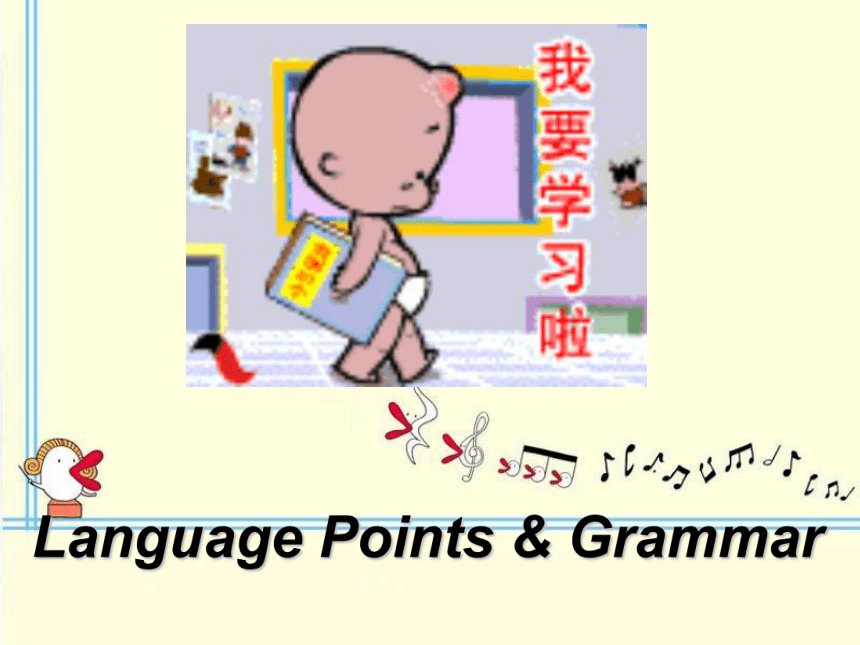 | |
| 格式 | rar | ||
| 文件大小 | 459.1KB | ||
| 资源类型 | 教案 | ||
| 版本资源 | 人教版(新课程标准) | ||
| 科目 | 英语 | ||
| 更新时间 | 2009-04-30 13:31:00 | ||
图片预览

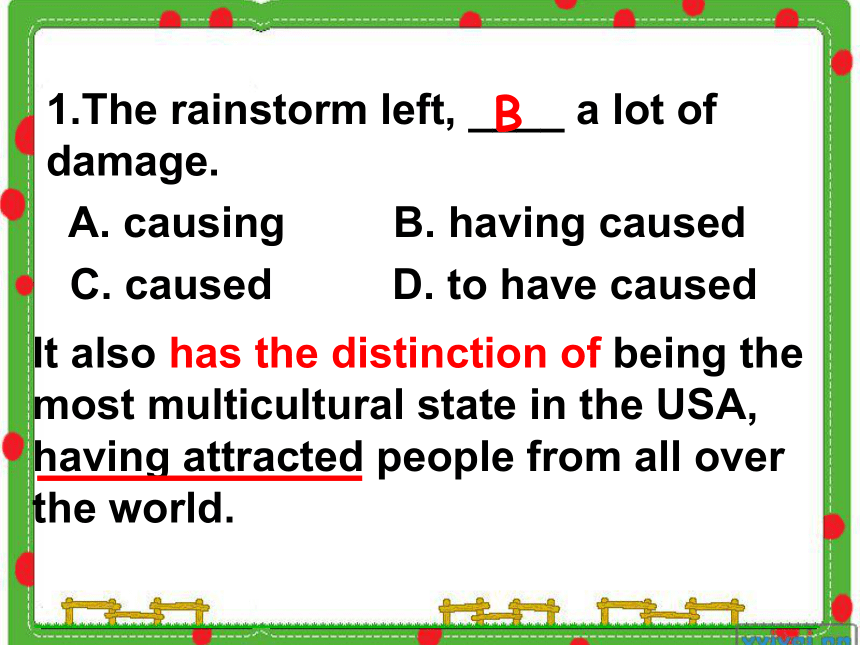
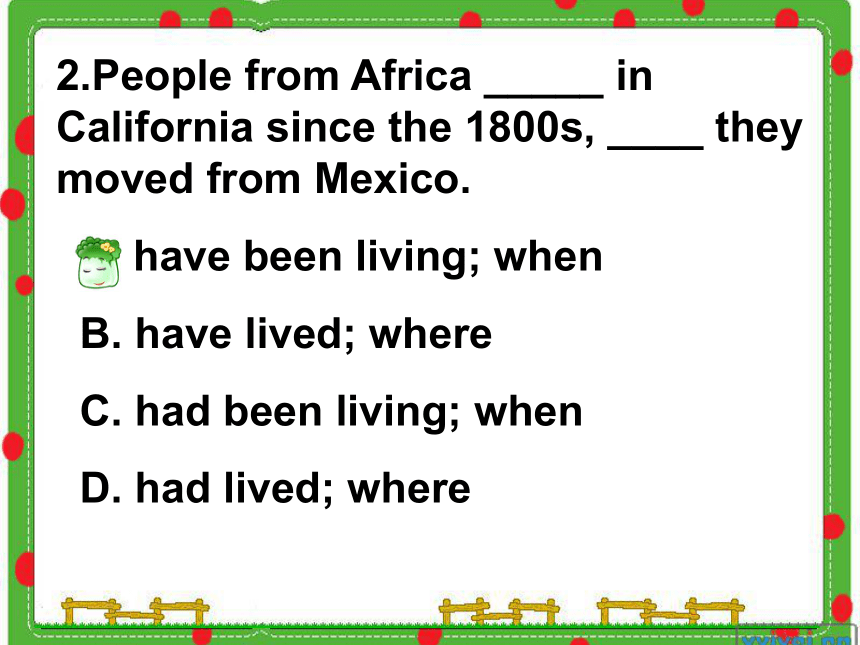
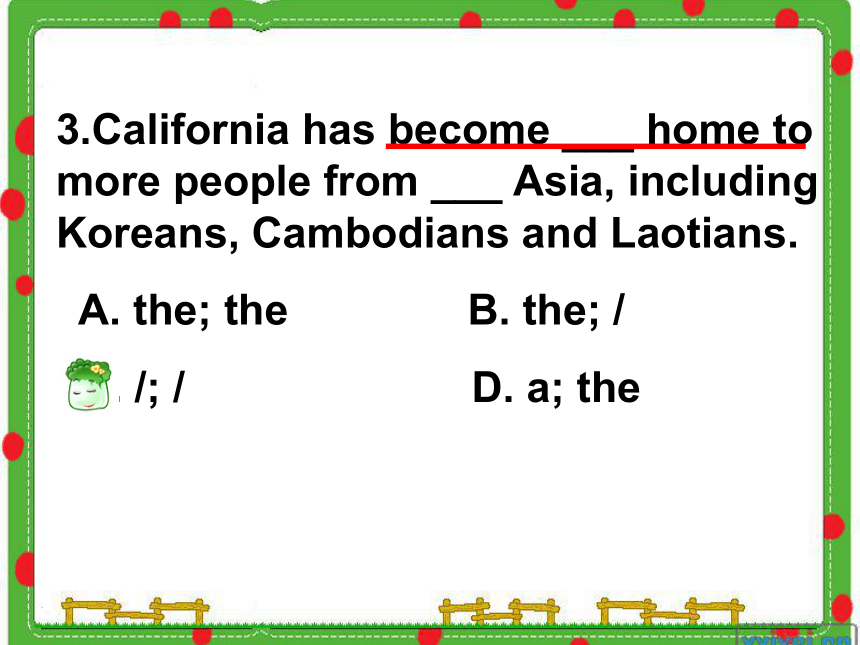
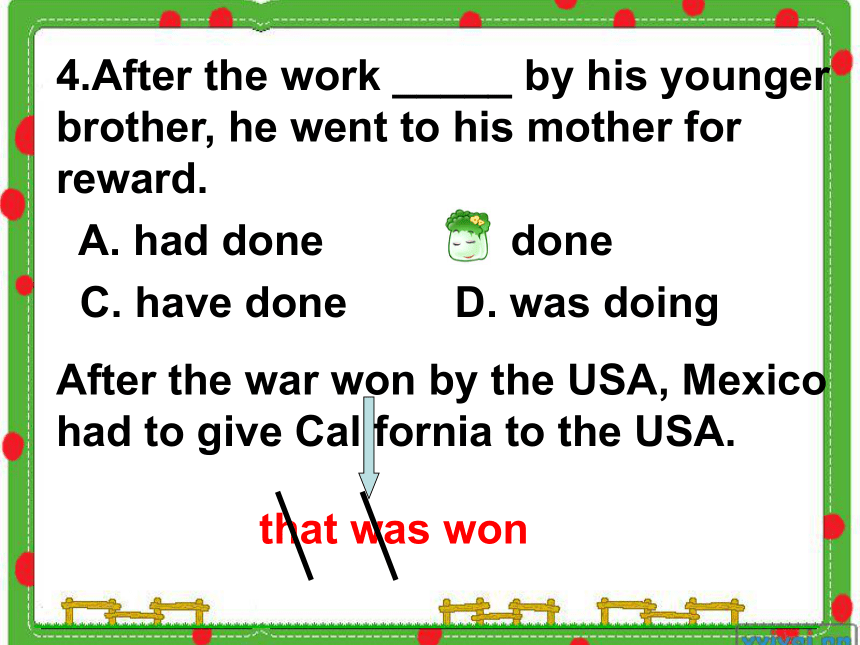
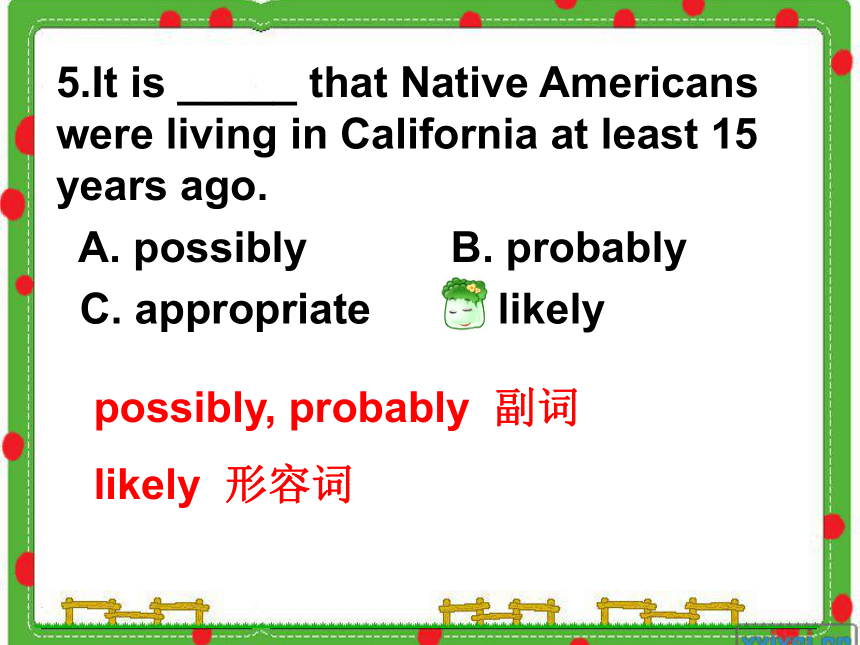
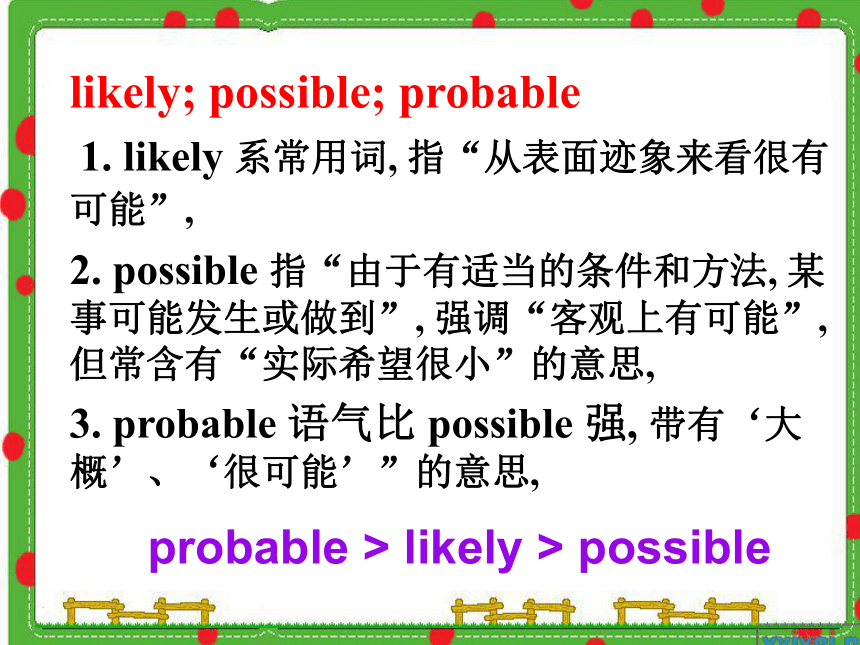
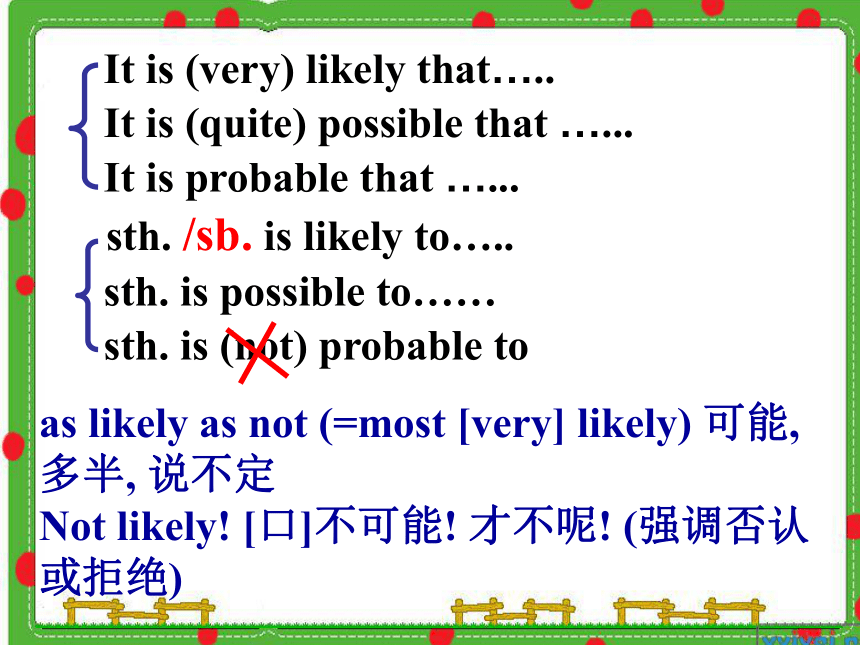
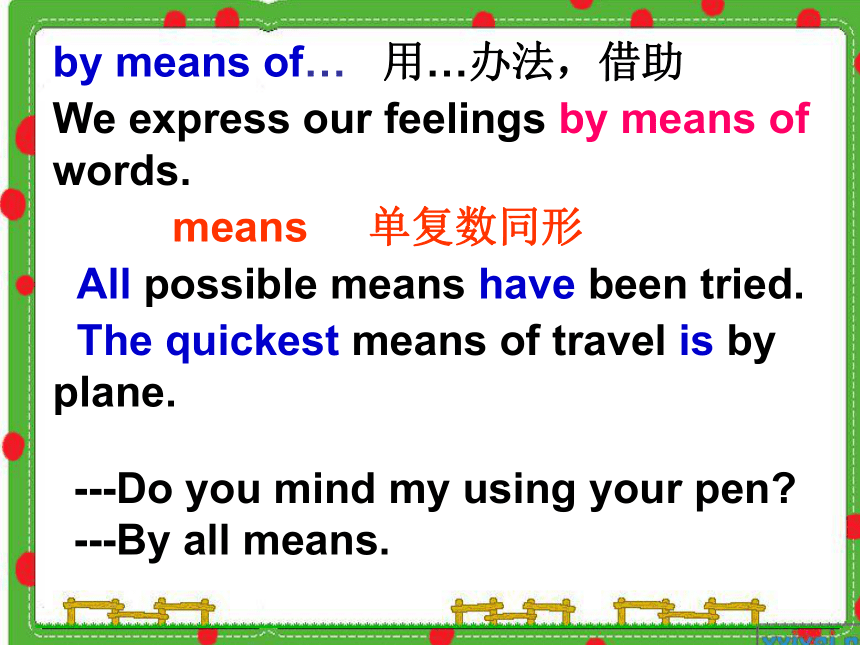
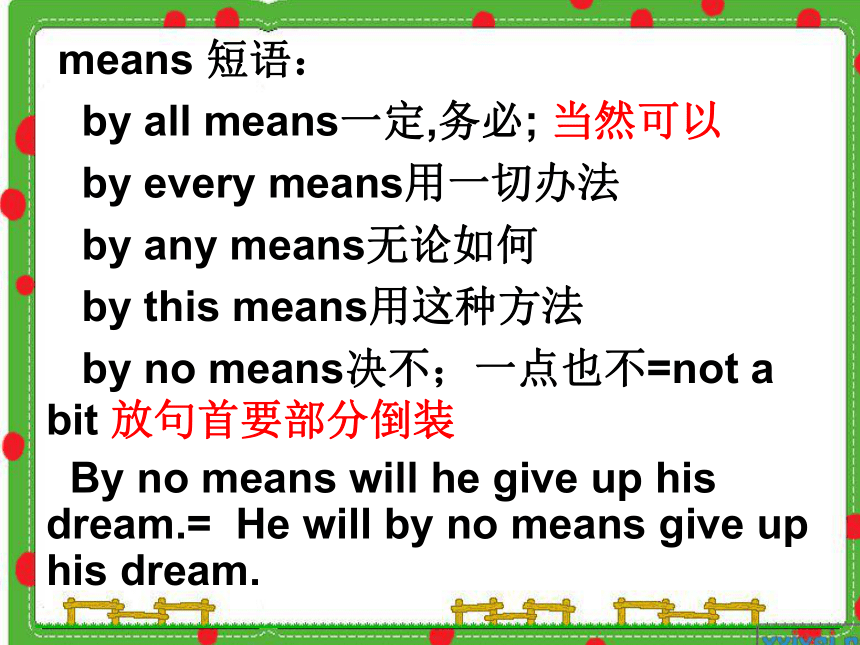
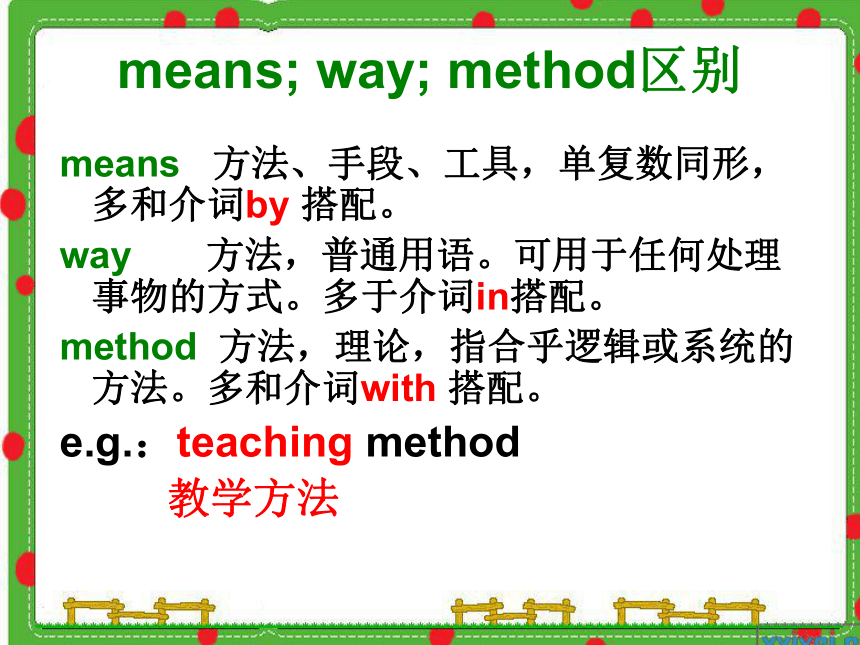
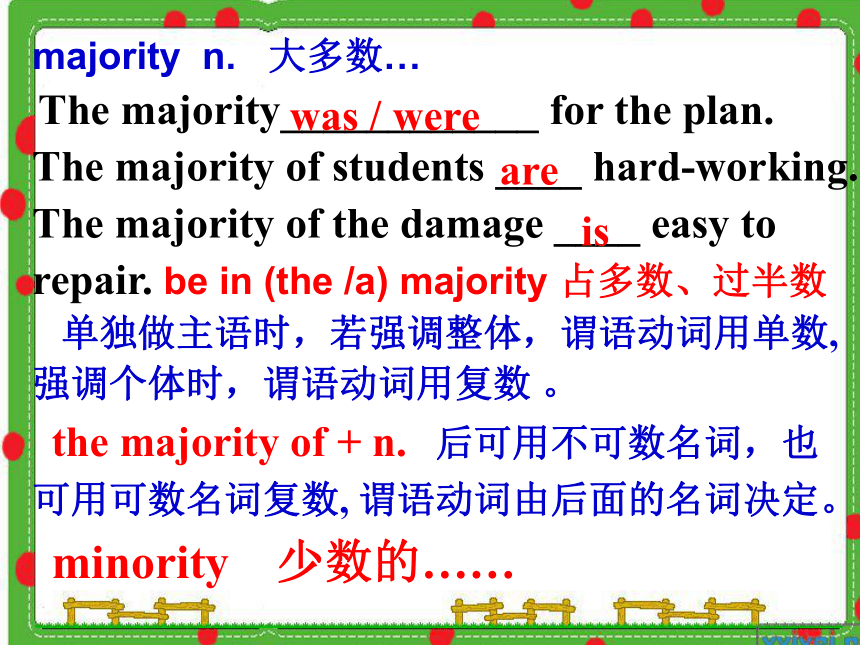
文档简介
课件30张PPT。Language Points & GrammarIt also has the distinction of being the most multicultural state in the USA, having attracted people from all over the world.1.The rainstorm left, ____ a lot of damage.
A. causing B. having caused
C. caused D. to have causedB2.People from Africa _____ in California since the 1800s, ____ they moved from Mexico.
A. have been living; when
B. have lived; where
C. had been living; when
D. had lived; where3.California has become ___ home to more people from ___ Asia, including Koreans, Cambodians and Laotians.
A. the; the B. the; /
C. /; / D. a; theAfter the war won by the USA, Mexico had to give California to the USA.4.After the work _____ by his younger brother, he went to his mother for reward.
A. had done B. done
C. have done D. was doingthat was won5.It is _____ that Native Americans were living in California at least 15 years ago.
A. possibly B. probably
C. appropriate D. likelypossibly, probably 副词
likely 形容词likely; possible; probable
1. likely 系常用词, 指“从表面迹象来看很有可能”,
2. possible 指“由于有适当的条件和方法, 某事可能发生或做到”, 强调“客观上有可能”, 但常含有“实际希望很小”的意思,
3. probable 语气比 possible 强, 带有‘大概’、‘很可能’”的意思, probable > likely > possible It is (very) likely that…..
It is (quite) possible that …...
It is probable that …...
sth. /sb. is likely to…..
sth. is possible to……
sth. is (not) probable to
as likely as not (=most [very] likely) 可能, 多半, 说不定
Not likely! [口]不可能! 才不呢! (强调否认或拒绝) by means of… 用…办法,借助
We express our feelings by means of words.
means 单复数同形
All possible means have been tried.
The quickest means of travel is by plane. ---Do you mind my using your pen?
---By all means. means 短语:
by all means一定,务必; 当然可以
by every means用一切办法
by any means无论如何
by this means用这种方法
by no means决不;一点也不=not a bit 放句首要部分倒装
By no means will he give up his dream.= He will by no means give up his dream.
means; way; method区别means 方法、手段、工具,单复数同形,多和介词by 搭配。
way 方法,普通用语。可用于任何处理 事物的方式。多于介词in搭配。
method 方法,理论,指合乎逻辑或系统的方法。多和介词with 搭配。
e.g.:teaching method
教学方法
majority n. 大多数…
The majority____________ for the plan.
The majority of students ____ hard-working.
The majority of the damage ____ easy to repair. be in (the /a) majority 占多数、过半数
单独做主语时,若强调整体,谓语动词用单数, 强调个体时,谓语动词用复数 。
the majority of + n. 后可用不可数名词,也可用可数名词复数, 谓语动词由后面的名词决定。
minority 少数的……
was / wereareis despite prep. 尽管;不管
in spite of
______the heavy rain, they were still searching for the lost plane.
A. Although B. Though
C. Despite D. AsThe Spanish had settled along the northwest coast of what we call the United States. ______ used to be a school ten years ago.
A. which B. where
C. what D. thatC6.The Spanish came to名词性从句Noun Clauses名词性从句在功能上相当于名词His job is important.What he does is important.主语This is his job.This is what he does every day.表语I don’t like his job.I don’t like what he does every day.宾语I don’t know about the man, Mr. White.I don’t know about the fact that he is a teacher.同位语1.______ he wants is a book.
2. ______ he wants to go there is obvious. 3.The result is ______ we won the game. 4.We should pay attention to ______ the teacher is saying.WhatThatthatwhatthat 和what 的选用that 和 what 都可引导所有的名词从句。 但是,what除起连接作用外,还在名 词性从句中充当成分,可做从句的主 语、宾语、或表语。而that在名词性从 句中不充当任何成分,只起连接作用。引导词that 的省略that 可省略的情况: 单个宾语从句中的that可省略that不可省略的情况: a. 主语从句 b. 表语从句 c. 同位语从句 d. 用it做形式宾语的宾语从句 e. 并列的宾语从句中的后几个从句的 引导词that 不能省略1. I asked her __________ she had a bike. 2.______ we will hold a party in the open air tomorrow depends on the weather. 3. We’re worried about ________ he is safe. 4. I don’t know ___________ he is well or not. 5. I don’t know ________ or not he is well. 6. The question is _________ he should do it. 7.The doctor can hardly answer the question ________ the old man will recover soon. 8. I don’t know _______ to go.if/whetherWhetherwhetherwhether/ifwhetherwhetherwhetherwhetherif 和whether 的选用不能使用if 的情况: a. 主语从句 b. 表语从句 c. 同位语从句 e. 介词后的宾语从句 f. whether to do 做动词宾语不能用if to do. g. whether or not 连在一起引导宾语从句时不用if.1.They expressed the hope ___they would come over to China.
A. which B. that
C. whom D. when
2.The fact___ he didn’t see Tom yesterday is true.
A. that B. which
C. when D. what
3.I have no idea ____he will come back.
A. where B. when
C. what D. that
4.Word has come ___ some American guests will come for a visit to our college next week.
A. what B. whether
C. that D. which
5. The news ___ surprised everybody yesterday now proves to be false.
A. that B. when
C. what D. how 同位语从句的引导和辨别1.同位语从句的格式:n.+ 连接词+从句 2.能接同位语从句的名词有: idea, fact, news, belief, thought, doubt, word, suggestion, proof, message, order, conclusion, desire, theory, truth 等 3.连接词通常是that,也可根据含义选用 whether, what, when, where 等来引导同位语从句。同位语从句和定语从句的区别1.定语从句是先行词的修饰语,它不涉及先行词的具体内容。定语从句中that不但起连接作用,而且在定语从句中充当一个句子成分,充当从句的宾语成分时可省略。2.同位语从句对中 心词的内容作进一步的解释和说明, 表明中心词的具体内容。引导同位语从句的that 在同位语从句中不做任何成分,只起连接作用,无具体含义,且不可省略.如果that作从句中的某一成分,则是定语从句,如果that不作从句中的任何成分,则是同位语从句.
例: (1). I had no idea that it was so late. (主系表结构,that 不作从句中的成分,同位语从句)
(2).I still remember the place that we visited last year.(主谓宾结构,that作从句中的宾语,定语从句)特殊句式1.I hate ___? when people talk with their mouths full.
A. it? B. that C. these D. them
2. I feel ____ strange that he should be so careless.
A. / B. it C. that D. how
3. It worried her a bit? ____ her hair was turning grey.
A. while B. that C. if? D. for 为了使句子保持平衡,常用it来代替主语从句或宾语从句,而把主语从句或宾语从句放到后面,尤其是连词that引导的主语从句常用于此种句式中。归纳
A. causing B. having caused
C. caused D. to have causedB2.People from Africa _____ in California since the 1800s, ____ they moved from Mexico.
A. have been living; when
B. have lived; where
C. had been living; when
D. had lived; where3.California has become ___ home to more people from ___ Asia, including Koreans, Cambodians and Laotians.
A. the; the B. the; /
C. /; / D. a; theAfter the war won by the USA, Mexico had to give California to the USA.4.After the work _____ by his younger brother, he went to his mother for reward.
A. had done B. done
C. have done D. was doingthat was won5.It is _____ that Native Americans were living in California at least 15 years ago.
A. possibly B. probably
C. appropriate D. likelypossibly, probably 副词
likely 形容词likely; possible; probable
1. likely 系常用词, 指“从表面迹象来看很有可能”,
2. possible 指“由于有适当的条件和方法, 某事可能发生或做到”, 强调“客观上有可能”, 但常含有“实际希望很小”的意思,
3. probable 语气比 possible 强, 带有‘大概’、‘很可能’”的意思, probable > likely > possible It is (very) likely that…..
It is (quite) possible that …...
It is probable that …...
sth. /sb. is likely to…..
sth. is possible to……
sth. is (not) probable to
as likely as not (=most [very] likely) 可能, 多半, 说不定
Not likely! [口]不可能! 才不呢! (强调否认或拒绝) by means of… 用…办法,借助
We express our feelings by means of words.
means 单复数同形
All possible means have been tried.
The quickest means of travel is by plane. ---Do you mind my using your pen?
---By all means. means 短语:
by all means一定,务必; 当然可以
by every means用一切办法
by any means无论如何
by this means用这种方法
by no means决不;一点也不=not a bit 放句首要部分倒装
By no means will he give up his dream.= He will by no means give up his dream.
means; way; method区别means 方法、手段、工具,单复数同形,多和介词by 搭配。
way 方法,普通用语。可用于任何处理 事物的方式。多于介词in搭配。
method 方法,理论,指合乎逻辑或系统的方法。多和介词with 搭配。
e.g.:teaching method
教学方法
majority n. 大多数…
The majority____________ for the plan.
The majority of students ____ hard-working.
The majority of the damage ____ easy to repair. be in (the /a) majority 占多数、过半数
单独做主语时,若强调整体,谓语动词用单数, 强调个体时,谓语动词用复数 。
the majority of + n. 后可用不可数名词,也可用可数名词复数, 谓语动词由后面的名词决定。
minority 少数的……
was / wereareis despite prep. 尽管;不管
in spite of
______the heavy rain, they were still searching for the lost plane.
A. Although B. Though
C. Despite D. AsThe Spanish had settled along the northwest coast of what we call the United States. ______ used to be a school ten years ago.
A. which B. where
C. what D. thatC6.The Spanish came to名词性从句Noun Clauses名词性从句在功能上相当于名词His job is important.What he does is important.主语This is his job.This is what he does every day.表语I don’t like his job.I don’t like what he does every day.宾语I don’t know about the man, Mr. White.I don’t know about the fact that he is a teacher.同位语1.______ he wants is a book.
2. ______ he wants to go there is obvious. 3.The result is ______ we won the game. 4.We should pay attention to ______ the teacher is saying.WhatThatthatwhatthat 和what 的选用that 和 what 都可引导所有的名词从句。 但是,what除起连接作用外,还在名 词性从句中充当成分,可做从句的主 语、宾语、或表语。而that在名词性从 句中不充当任何成分,只起连接作用。引导词that 的省略that 可省略的情况: 单个宾语从句中的that可省略that不可省略的情况: a. 主语从句 b. 表语从句 c. 同位语从句 d. 用it做形式宾语的宾语从句 e. 并列的宾语从句中的后几个从句的 引导词that 不能省略1. I asked her __________ she had a bike. 2.______ we will hold a party in the open air tomorrow depends on the weather. 3. We’re worried about ________ he is safe. 4. I don’t know ___________ he is well or not. 5. I don’t know ________ or not he is well. 6. The question is _________ he should do it. 7.The doctor can hardly answer the question ________ the old man will recover soon. 8. I don’t know _______ to go.if/whetherWhetherwhetherwhether/ifwhetherwhetherwhetherwhetherif 和whether 的选用不能使用if 的情况: a. 主语从句 b. 表语从句 c. 同位语从句 e. 介词后的宾语从句 f. whether to do 做动词宾语不能用if to do. g. whether or not 连在一起引导宾语从句时不用if.1.They expressed the hope ___they would come over to China.
A. which B. that
C. whom D. when
2.The fact___ he didn’t see Tom yesterday is true.
A. that B. which
C. when D. what
3.I have no idea ____he will come back.
A. where B. when
C. what D. that
4.Word has come ___ some American guests will come for a visit to our college next week.
A. what B. whether
C. that D. which
5. The news ___ surprised everybody yesterday now proves to be false.
A. that B. when
C. what D. how 同位语从句的引导和辨别1.同位语从句的格式:n.+ 连接词+从句 2.能接同位语从句的名词有: idea, fact, news, belief, thought, doubt, word, suggestion, proof, message, order, conclusion, desire, theory, truth 等 3.连接词通常是that,也可根据含义选用 whether, what, when, where 等来引导同位语从句。同位语从句和定语从句的区别1.定语从句是先行词的修饰语,它不涉及先行词的具体内容。定语从句中that不但起连接作用,而且在定语从句中充当一个句子成分,充当从句的宾语成分时可省略。2.同位语从句对中 心词的内容作进一步的解释和说明, 表明中心词的具体内容。引导同位语从句的that 在同位语从句中不做任何成分,只起连接作用,无具体含义,且不可省略.如果that作从句中的某一成分,则是定语从句,如果that不作从句中的任何成分,则是同位语从句.
例: (1). I had no idea that it was so late. (主系表结构,that 不作从句中的成分,同位语从句)
(2).I still remember the place that we visited last year.(主谓宾结构,that作从句中的宾语,定语从句)特殊句式1.I hate ___? when people talk with their mouths full.
A. it? B. that C. these D. them
2. I feel ____ strange that he should be so careless.
A. / B. it C. that D. how
3. It worried her a bit? ____ her hair was turning grey.
A. while B. that C. if? D. for 为了使句子保持平衡,常用it来代替主语从句或宾语从句,而把主语从句或宾语从句放到后面,尤其是连词that引导的主语从句常用于此种句式中。归纳
